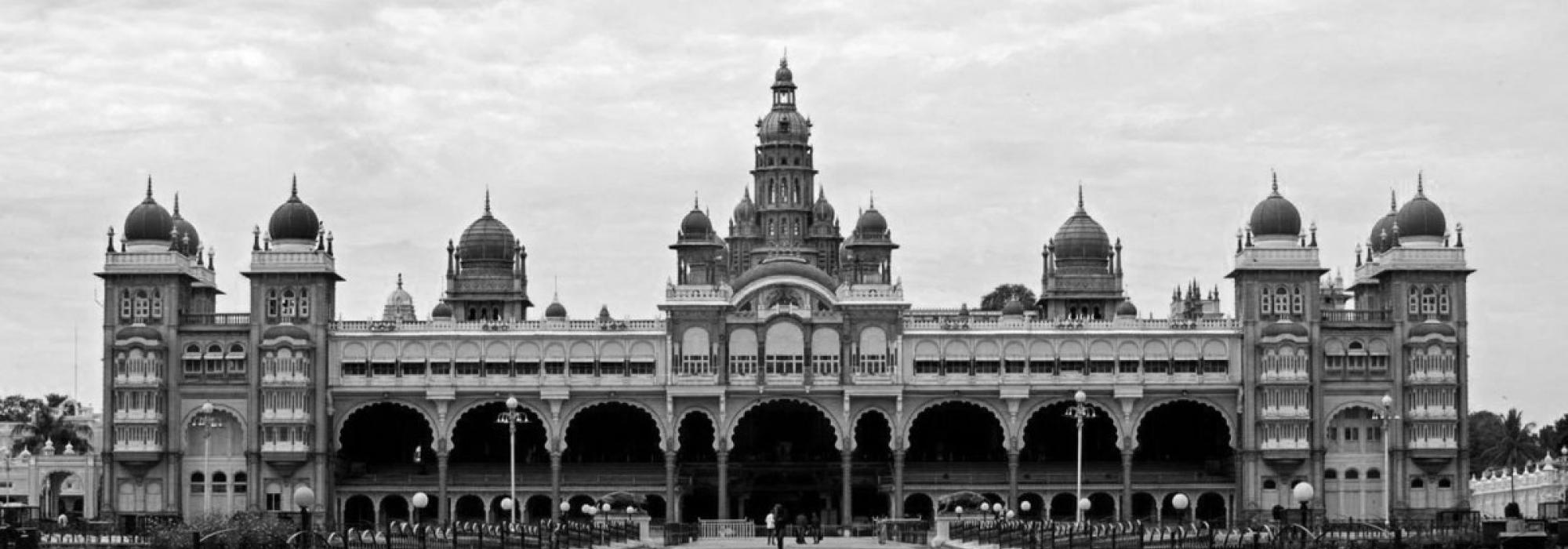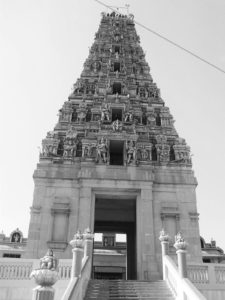From what I’ve heard, Sri Vasudeva Sastri hailed from Doddaballapura. His Highness the Maharaja of Mysore bestowed upon him the title of “Vidyanidhi” (literally: Treasure of Knowledge). Perhaps he was the first in a line of scholars to receive the “Vidyanidhi” honorific. He also earned renown as “Jaganmithya” Vasudeva Sastri. In a Vakyartha[i] conducted in the presence of the Sringeri Jagadguru, Sri Vasudeva Sastri propounded the Advaitic tenet of “Brahma Satyam Jaganmithyaa” (literally, “Brahman is the Truth/Ultimate Reality, the physical world is a manifestation of illusion”) and established its veracity by quoting from the Vedas. Appreciating his scholarship, oratory and line of reasoning, the Jagadguru praised him with the “Jaganmithya” prefix.
The Family of his Disciples
Sri Vasudeva Sastri was unrivalled in the schools of Tarka (Logic), Vyakarana (Grammar) and Mimamsa (literally, “critical philosophical investigation.” It’s one of the six schools of Indian Philosophy). Numerous well-known Pandits in Bangalore were his disciples. I had the great fortune of interacting with two or three of his disciples. Chief among them were Saaggere Narayana Sastri, Devanagondi Narayana Sastri, Doddabele Narayana Sastri, and Sondekoppa Venkatesha Sastri. I have forgotten the names of the rest. In any case, the spread and swathe of Sri Vasudeva Sastri's family of disciples was vast.
Doddabele Narayana Sastri
Sri Doddabele Narayana Sastri has rendered immense service to Kannada literature. He has authored word-by-word translations and learned commentaries on such literary works as the Jaimini Bharata.[ii] He has also authored and published commentaries on Sanskrit texts like the Bhagavad Gita, Viveka Chudamani, Raghuvamsa and other works. In Kannada, he has written a book titled “Devara Seve” (Service of God), a Bhajan titled, “Hanuman Nama Amruta,” (Nectar of the Names of Hanuman) and numerous other booklets. In those days, Bhajans in the nature[iii] of “Shuddha Brahma Paratpara Rama” were enormously popular. Following this pattern, Sri Doddabele Narayana Sastri authored similar Bhajans devoted to Shiva, Hanuman, and other deities. Sri Doddabele Narayana Sastri was a good orator and displayed enormous courage in Vakyarthas. Under the aegis of the Sri Shivaganga Shankara Matha, Sri Naryana Sastri ran a monthly titled Sharada and after some time, another monthly titled Vidyananda. It was in these monthlies that the aforementioned writings on the Bhagavad Gita, Vivekachudamani and others were first published. Apart from these traditional texts which were of immense value, he also wrote numerous episodes from the Shastras, and anecdotes from literature. His writing style was aimed at a popular audience and was clear and simple.
Sri Devanagondi Narayana Sastri
I learnt Tarka under the tutelage of Sri Devanagondi Narayana Sastri for a brief period of time. I eventually came to know of the sorry state of his finances. I wrote a letter to B. Ramakrishna Rao, the Controller of the (Mysore) Palace detailing out the difficult condition of this great scholar. I received no response even after four or five months. On a fine afternoon, I was working on something in the office of the Karnataka paper located in the Gundopant Street. Sri Devanagondi Narayana Sastri arrived. He had an envelope in his hand. Me: “Please sit.” Sri Sastri (in Telugu): “You’re younger to me. I feel like doing Namaskar to you.” His face showed a piteous expression as he said this. It appeared as though his eyes would fill with tears. I stopped his attempt to bow down to me in Namaskar and said, “what’s the matter?” He placed the envelope in my hand and asked me to open it. A letter from the Palace: “Vidwan Devanagondi Narayana Sastri has hereby been appointed as the Palace Vidwan.” I let out a silent prayer of gratitude to Sri Ramakrishna Rao and asked Sri Sastri: “How does this appointment benefit you?” Sri Sastri: “I’ll get about five or six rupees every month from this.” Me: “That’s all? Why did you utter such big words just for this?” The actual crux of the matter lay in the reply he gave to this question: “Swami, you’re still very young. People like you must learn about the appalling condition of people like us. I was the disciple of Sri Saaggere Narayana Sastri. I visited his home one afternoon. He was sitting in deep worry, hands on his knee, his face buried in his hands. He just sat there like that, didn’t even lift his head to look at me. Whenever he saw me, he would unfailingly say, “come here, my boy.” That day, he didn’t even realize that I was there. His mind was preoccupied, far, far away. After about two minutes, I asked, “Sri Sastri, what’s the matter? Do you have headache?” Then he lifted his head up, looked in my direction, smiled a bit and said, “Yes, my boy, it’s headache. It has hit me today, it’s waiting for you tomorrow.” I asked, “Why do you say that?” He said: “I learned Tarka under my Guru, Sri Vasudeva Sastri for twelve years. This headache is the fruit of that. I need to perform my father’s Shradda (annual death ceremony) day after tomorrow. I was thinking about some means to arrange for the items required for it. The shopkeepers who would give me credit have given all that they could and have now stopped it. There’s no way I can approach them for credit again. Now I’m thinking where I should go. And so, instead of learning Tarka, if I had taken up a job as a clerk or schoolteacher, I wouldn’t have suffered this headache. You understand this reality at least now. This is the only benefit of learning Tarka. The infant has died but only the smell of its clothes in the cradle has remained. My Shastra-learning is complete. What has remained is just headache.” “My current fate is the same. Now, because you have helped me obtain this salary from the Palace, I can be assured of eating at least one gruel every day. For this, I offer a thousand Namaskars to Parameshwara!” Sri Devanagondi Narayana Sastri was endowed with utmost self-respect and integrity. He was deeply traditional. He never raised his voice. At times, I would tease him playfully: “Those learned in Tarka are typically loudmouths. Given this, how is it that you are so soft-spoken and gentle!”
* * *
Vidyanidhi Sri Vasudeva Sastri’s house was expansive. It stretched all the way from Gundopant Street to Old Tharagupet. He provided meals and imparted lessons to scores of students. He normally taught the following subjects—Tarka, Vyakarana, Purva Mimamsa, Uttara Mimamsa, and Jyothisa. His students eventually went on to earn prestige as accomplished scholars. Sri Vasudeva Sastri belonged to the Velanadu Sect. Prominent among his relatives was Sri V B Subbaiah, proprietor of various printing presses and publishing houses (even today, V B Subbaiah and Sons[iv] is a flourishing organization).
Sri Subrahmanya Sastri
Subra
Sri Vasudeva Sastri’s brother-in-law was Sri Siddhanti Subrahmanya Sastri, a renowned name in Jyotisha (Astronomy). He has authored commentaries on Kannada works such as Siddarama Purana. He used to publish the Panchagam (the traditional Hindu almanac) under the patronage of the Sringeri Matha. Sri Subrahmanya Sastri has written a translation of a Sanskrit work titled Upanishad Saara. In it, he has provided the essence and summary of the Upanishads and the Brahmasutras. His close friend was Garani Vayyakarani Krishnacharya. Sri Siddhanti Subrahmanya Sastri’s son was the famous “Mahamahopadhyaya” Shivashankara Sastri. Like his father, he too was a great Pandit in numerous Sastras and in the Sanskrit and Kannada languages.
Sri Shivashankara Sastri
Sri Shivashankara Sastri had adorned the post of the President of the Kannada Literary Conference held in Bijapur. If memory serves me right, his entire Presidential address was composed in the form of a poem. He had the felicity to effortlessly compose a poem in various styles such as the Kanda starting with any alphabet. His linguistic usage was completely faithful to grammatical rules. However, those who weren’t acquainted with traditional knowledge and usages found it difficult to understand his poetry.
Chinmaya rUpanIshanabhavaM sale rAjise cittadoL sanmati sadviDhEya sivasaMkara sarmaninAdudu buddhibhA- svanmahanIyarellaridanOdi…
Sri Shivashankara Sastri attempted another innovation. He would consider the Venkatesha Sahasranamam, Shiva Sahasranamam, Lalita Sahasranamam, Ganesha Sahasranamam, and Surya Sahasranamam, and using each of them as the base, he would compose a poem showing their meaning. A total of five thousand verses. Of these, he published the first five hundred or eight hundred verses through Bangalore Press on fine paper. The printing was truly elegant. At places, there were pictures of the respective Deities alongside the verses. I had witnessed them even as the work was in progress. The beauty was stunning. I haven’t seen that level of scholarship, that masterful decisiveness, that sheer courage, that singular zeal elsewhere. Even when he sat down to deliver a discourse, Sri Shivashankara Sastri displayed the same command over oratory. Sri Sastri was a Daivajna—typically known as an astrologer. He had learned the secrets of Mantra and Tantra. He was a devotee of Subrahmanya. Sri Bellave Venkatanaranappa stayed in Madras for several months to pursue his MA degree. Sri Venkatanaranappa’s fidelity towards studies was exemplary. He sacrificed food and sleep in order to acquire learning and to obtain his degree. He pursued his studies in the manner of performing Tapas (penance), constantly reading, writing, and practicing mathematical problems. As a result, he came down with fever. Apparently, he would lapse into unconsciousness on several occasions. In those days, he lived in Ulsoorpet near V B Subbaiah’s home. Venkatanaranappa’s folks grew anxious about his health and informed Sri Subbaiah who in turn conveyed the news to Sri Shivashankara Sastri. Then, Sri Shivashankara Sastri administered Vibhuti, Kumkum, Bilva leaves and Akshata and cured Venkatanaranappa. Towards the closing days of his life, Sri Shivashankara Sastri took over the administration of the Subrahmanya Swami Temple located atop the Mount Joy Hillock in Bangalore from the Government. He religiously conducted Pujas and showered his blessings on the Bhaktas who visited it. He built and consecrated a new Ashtabhuja (literally, eight-armed) Ganapati Murti there. I was present at the consecration ceremony. The Hillock acquired a new halo. pratyakshAdbhuta ShaNmuKha mrityunjaya srI kumAra giri shrungaM | bhaktyA praNamata….shivalingaM || Bhaktas who were tormented by evil planets, who were suffering from illness, epilepsy and leprosy and who were otherwise in trouble would come to this Subrahmanya Temple and take treatments involving Mantra and Tantra.
This is the English translation of the eleventh chapter of D V Gundappa’s Jnapakachitrashaale: Volume 5 – Vaidikadharma Sampradayastharu.
Notes:
[i] Typically, a philosophical debate held in public where numerous learned traditional scholars debate on various points of Hindu philosophical schools in the presence of a judge who is also equally, if not more learned.
[ii] A Kannada poetic rendering of the Mahabharata authored by the 16th—17th century poet, Lakshmisha.
[iii] This Bhajan in question continues to remain popular. It narrates the entire Ramayana in a simple and easy-to-remember verse form where each line of each verse ends with “Rama.”
[iv] DVG wrote this in 1972. V B Subbaiah and Sons is still a name to reckon with in the printing industry.















































